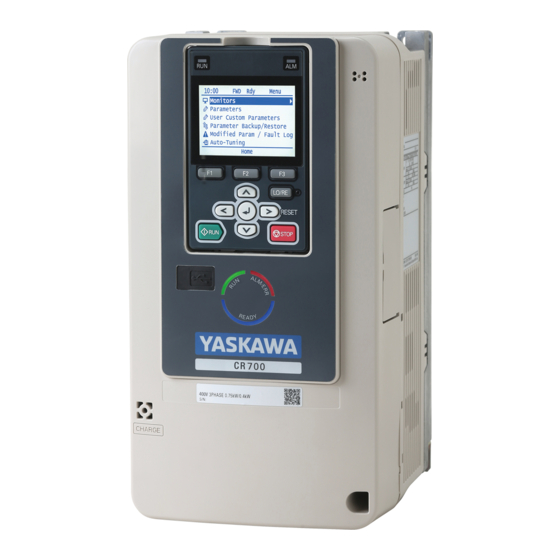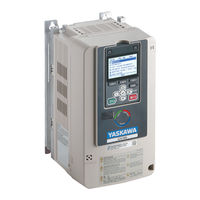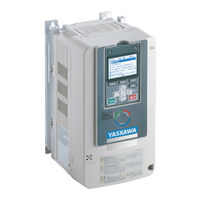
YASKAWA CR700 Drive for Cranes Manuals
Manuals and User Guides for YASKAWA CR700 Drive for Cranes. We have 7 YASKAWA CR700 Drive for Cranes manuals available for free PDF download: Technical Manual, Quick Start Manual, Manual, Installation Manual
YASKAWA GA700, GA800, CH700, CR700, LA700, ES700 Manual
Brand: YASKAWA
|
Category: CD/CDR Drive
|
Size: 4 MB
Table of Contents
Advertisement
YASKAWA CR700 Technical Manual (894 pages)
AC Drive
Table of Contents
-
Receiving14
-
Glossary14
-
Receiving19
-
Nameplate22
-
(Rcm/Rcd)125
-
Decrease Noise130
-
Wiring Checklist134
-
Section Safety138
-
LCD Display140
-
LED Status Ring145
-
Keypad Operation147
-
Show the Monitor148
-
Auto-Tuning188
-
Load Test Runs193
-
Run Command194
-
Speed Reference195
-
Brake Sequence195
-
Command231
-
Lowering233
-
Function234
-
Function235
-
Counterweight235
-
Drive236
-
AOLV Control240
-
Section Safety246
-
EMC Directive262
-
UL Standards273
-
Area of Use273
-
对应中国Rohs指令294
-
本产品中含有有害物质的信息294
-
Precautions296
-
Section Safety300
-
Message Format305
-
Enter Command311
-
Self-Diagnostics312
-
Error Codes332
-
Troubleshooting333
-
Section Safety334
-
Fault342
YASKAWA CR700 Technical Manual (886 pages)
Table of Contents
-
Receiving14
-
Glossary14
-
Receiving19
-
Nameplate22
-
(Rcm/Rcd)125
-
Decrease Noise130
-
Wiring Checklist134
-
Section Safety138
-
LCD Display140
-
LED Status Ring145
-
Keypad Operation147
-
Show the Monitor148
-
Auto-Tuning188
-
Load Test Runs193
-
Run Command194
-
Speed Reference195
-
Brake Sequence195
-
Command231
-
Lowering233
-
Function234
-
Function235
-
Counterweight235
-
Drive236
-
AOLV Control240
-
Section Safety246
-
EMC Directive262
-
UL Standards273
-
Area of Use273
-
对应中国Rohs指令294
-
本产品中含有有害物质的信息294
-
Precautions296
-
Section Safety300
-
Message Format305
-
Enter Command311
-
Self-Diagnostics312
-
Error Codes332
-
Troubleshooting333
-
Section Safety334
-
Fault342
Advertisement
YASKAWA CR700 Technical Manual (773 pages)
AC Drive For Cranes 200/400 V class: 0.4 to 110/315 kW
Table of Contents
-
Receiving13
-
Glossary13
-
Receiving17
-
Nameplate18
-
(Elcb)106
-
Decrease Noise109
-
Wiring Checklist113
-
General Safety116
-
LCD Display119
-
LED Status Ring122
-
Keypad Operation123
-
Set Data to Log151
-
Auto-Tuning163
-
Load Test Runs168
-
Run Command170
-
Speed Reference170
-
Brake Sequence171
-
Command209
-
Lowering212
-
Function213
-
Counterweight214
-
AOLV Control222
-
General Safety225
-
EMC Directive245
-
UL Standards255
-
Area of Use255
-
对应中国Rohs指令280
-
本产品中含有有害物质的信息280
-
Precautions281
-
Message Format288
-
Enter Command294
YASKAWA CR700 Quick Start Manual (128 pages)
AC Drive
Brand: YASKAWA
|
Category: Media Converter
|
Size: 22 MB
Table of Contents
-
2 Safety
6 -
YASKAWA CR700 Installation Manual (28 pages)
AC Drive
Brand: YASKAWA
|
Category: CD/CDR Drive
|
Size: 4 MB
Table of Contents
Advertisement






